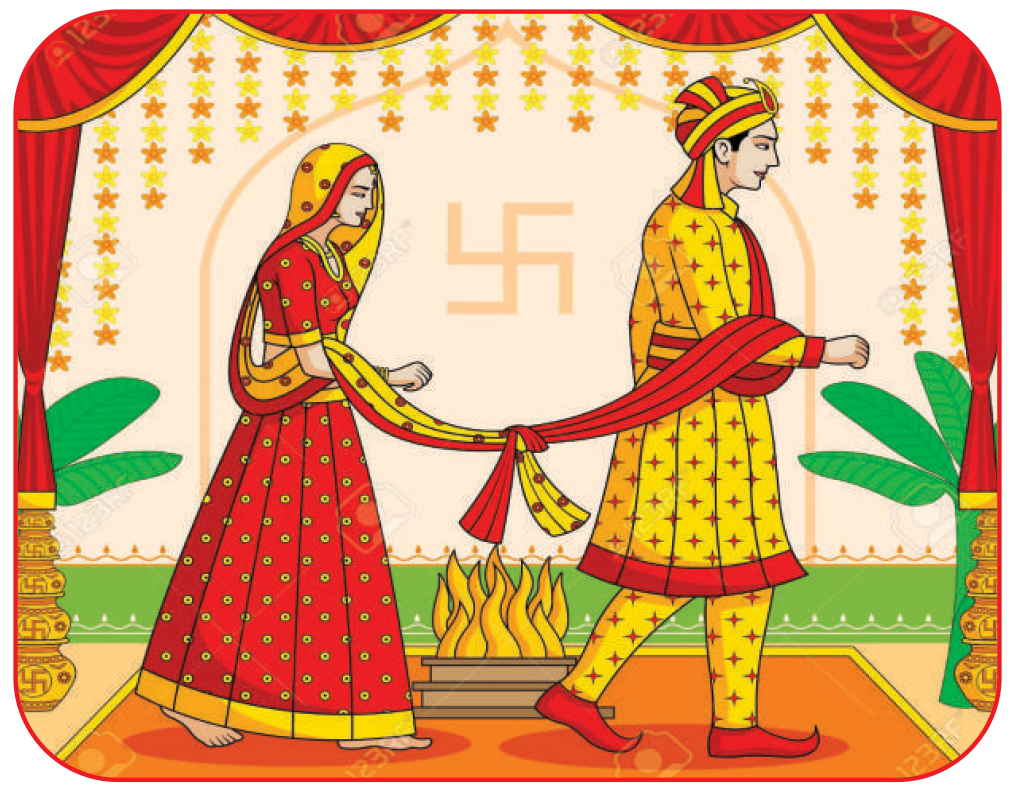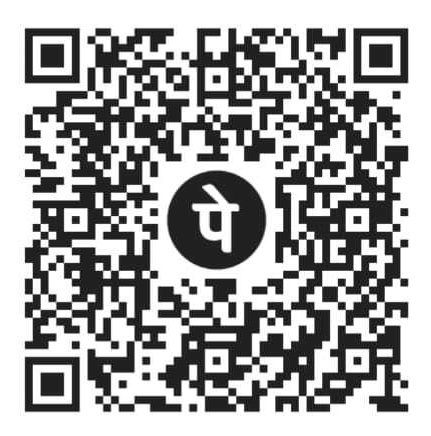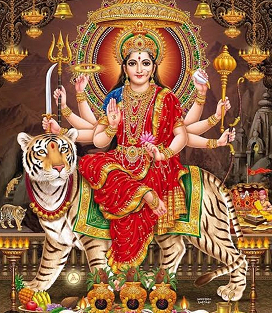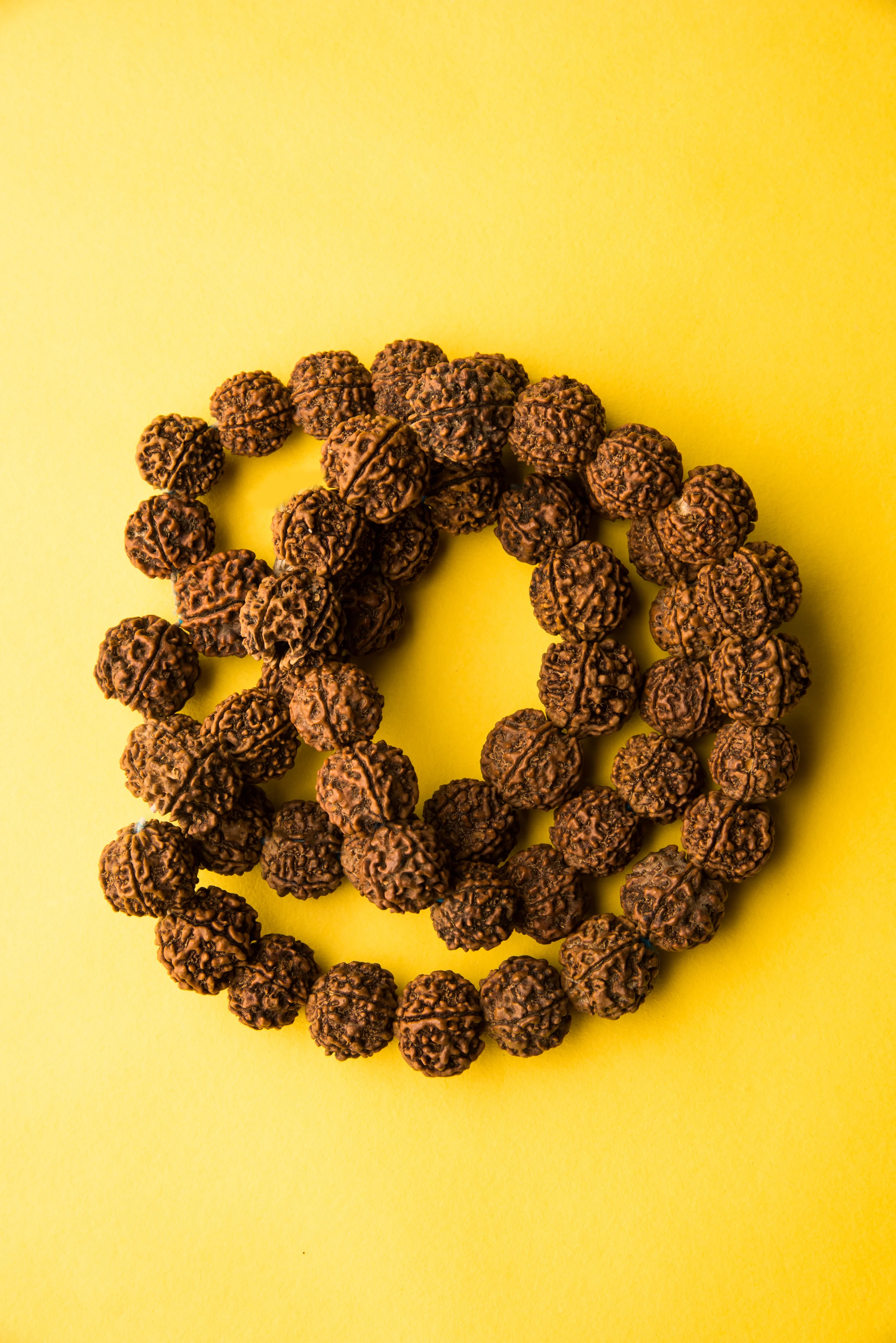
Marriage - Discussion
यथा वायुं समाश्रित वर्तन्ते सर्वजन्तवः । तथा गृहस्थ्माश्रित्य वर्तन्ते सर्व आश्रमाः ।।
यस्मात् त्रयोऽप्याश्रमिणों ज्ञानेनात्रेन चान्वहम् । ग्रहस्थेनैव धार्यन्ते तस्माज्ज्येष्ठाश्रमो गृही ।।
स सन्धार्यः प्रयत्नेन स्वर्गमक्षयमिच्छता । सुख चेहेच्छता नित्यं योऽधार्थी दुर्बलेन्द्रियैः ।।
( मनुस्मृति 3, 77-79 )
Meaning
Just as all beings depend on air for survival, all ashrams rely on the Grihastha ashram. It supports the other three with knowledge and sustenance. Hence, Grihastha is superior to the others. Weak-willed individuals cannot uphold it. Marriage is the foundation of social activities.
Horoscope Matchmaking
Marriage - Compatibility (Vivaha - Melapak)
The Glory of Grihastha Ashrama as Explained by Dharmasutra Commentator Haradatta
यस्तेऽड्कुशो वसुदानो वृहत्रिन्द हिरण्मयः। तेन जनीयते जायां महां घेहि शचीपते ।।
All Vedas, scriptures, historical texts, and Puranas primarily emphasize the duties and responsibilities of Grihastha Ashrama (household life). According to all Acharyas, Grihastha Ashrama is central. If a man is unable to fulfill its responsibilities, other Ashramas (Brahmacharya, Vanaprastha, and Sannyasa) are prescribed for him.
सर्वेषु वेदशास्त्रेतिहासपुराणेषु गृहस्थधर्मा एवाग्निहोत्रादयः प्राध्येण विधीयन्ते। ततः सर्व एवाचार्या गार्हस्थ्स्यैकाश्रम्यं प्राधान्यं मन्यन्ते तत्राशक्तानामित्राश्रमधर्मा विधीयन्ते।
From Vedic Samhitas, Brahmanas, and Aranyakas to modern times, entry into Grihastha Ashrama has been considered the foundation of social life. This Ashrama is incomplete without a wife (as per Vishnudharmottara Purana). According to Parashara, a man is not considered a Grihastha simply by owning a house; he attains the status of a householder only when he has a wife.
न गृहण गृहस्यः स्याद् भार्यया कथ्यते गृही।
(बृहत्पराशरस्मृति 6.01)
A persons existence expands in two directions: The material world The world of subtle emotions and experiences. It is an ironic paradox that while humanity continues to raise the flags of victory in the material world, it simultaneously writes more stories of emotional defeat.
While man enjoys external prosperity, luxury, and celebrations, internally, he struggles with loneliness and a sense of defeat. When sexual attraction aligns with social ethics and values, it transforms into marriage. Marriage is an emotion that encompasses joy and sorrow, success and failure, elation and despair.
Before marriage, many questions about ones life partner arise in the mind, creatingcuriosity and concern. In this context, astrology plays a crucial role. According to Indian belief, proper matchmaking (Var-Vadhu selection) is essential for a happy and prosperous married life.
Innovative Research-Based Matchmaking Methods
While matching horoscopes for marriage, the first and foremost step is to analyze the age, temperament, nature, mental and physical constitution, and character of both the bride and groom. Several classical methods are available for this purpose, some of which are listed below:
- (1) Lagna (Ascendant)
- (2) Nakshatra (Constellation)
- (3) Graha (Planetary) Matching
(1) Lagna Matching: The relationship between the ascendants (Lagna) of the bride and groom is a crucial factor in determining compatibility. In general, ascendants belonging to the same element indicate a harmonious married life. If the ascendants are in a 7th house (opposite) relationship, the marriage will still be successful.
- Same ascendant is considered ideal for a blissful marriage.
- A match between water and earth elements is auspicious.
- A match between water and fire elements may create disharmony in married life.
- Air and fire elements together form a favorable union.
The compatibility of ascendant elements is known as Lagna Matching. Just as birth chart matching considers the zodiac signs of the bride and groom, Lagna Matching evaluates their personality, mental structure, natural tendencies, talents, strengths, and weaknesses. Even if complete alignment is not achieved, if the elemental compatibility is favorable, the marriage is likely to be successful. The four elements and their corresponding zodiac signs:
- Fire Element: Aries (Mesha), Leo (Simha), Sagittarius (Dhanu)
- Earth Element: Taurus (Vrishabha), Virgo (Kanya), Capricorn (Makara)
- Air Element: Gemini (Mithuna), Libra (Tula), Aquarius (Kumbha)
- Water Element: Cancer (Karka), Scorpio (Vrishchika), Pisces (Meena)
Nakshatra Matching: Among all horoscope matching techniques, Nakshatra Matching is the most widely used. This method considers 36 Gunas (qualities), and if at least 18 Gunas match between the bride and groom, the marriage is considered permissible.
According to astrological traditions, a minimum of 18 matching Gunas is essential for a happy and prosperous married life.
Since the Moon is the closest celestial body to Earth, astrologers give it special significance in matchmaking. A fulfilling, meaningful, and successful marriage requires mutual mental harmony and compatibility between husband and wife.

Intellectual compatibility plays a crucial role in resolving conflicts and maintaining harmony in married life. In today’s fast-paced and socially dynamic world, where relationships have become more formal, mental synchronization between partners is more essential than ever
Nakshatra matching is divided into eight categories, each assigned a specific number of points:
- Varna – 1 point
- Vashya – 2 points
- Tara – 3 points
- Yoni – 4 points
- Graha Maitri – 5 points
- Gana – 6 points
- Bhakoot – 7 points
- Nadi – 8 points
Varna Koota: The ancient sages of India, following the principles of occupational classification, divided society into four Varnas—Brahmin, Kshatriya, Vaishya, and Shudra. According to this system, the zodiac signs are also classified:
- Brahmin Varna: Pisces, Cancer, Scorpio
- Kshatriya Varna: Leo, Sagittarius, Aries
- Vaishya Varna: Taurus, Virgo, Capricorn
- Shudra Varna: Gemini, Libra, Aquarius
A match within the same Varna or where the groom belongs to a higher Varna is deemed auspicious. This category is assigned 1 point.
Vashya Koota: This category, allocated 2 points, assesses the intensity of mutual attraction between the bride and groom. The zodiac signs influence attraction as follows:
- Aries attracts Leo and Scorpio.
- Taurus attracts Cancer and Libra.
- Gemini attracts Libra.
- Libra attracts Capricorn and Virgo.
- Scorpio attracts Cancer.
- Sagittarius attracts Pisces.
- Capricorn attracts Aries and Aquarius.
- Aquarius attracts Aries.
- Pisces attracts Capricorn.
Tara or Dina Koota: This aspect, valued at 3 points, involves counting from the bride’s Nakshatra (birth star) to that of the groom. The resulting number is divided by 9. If the remainder is 2, 4, 6, 8, or 0, the match is considered favorable.
Yoni Koota: Assigned 4 points, this category examines sexual compatibility, temperament, and mutual harmony.
- Same Yoni: 4 points (Highly Auspicious)
- Friendly Yoni: 3 points
- Neutral Yoni: 2 points
- Different Yoni: 1 point
- Enemy Yoni: 0 points (Incompatible)
A match within the same Varna or where the groom belongs to a higher Varna is deemed auspicious. This category is assigned 1 point.
- Enemy Yoni must always be avoided.
- Friendly or neutral Yoni is acceptable.
- Same Yoni is highly favorable.
Graha Maitri Koota: This category, rated 5 points, evaluates the natural friendship between the ruling planets of the bride and groom’s birth signs. A harmonious planetary relationship indicates a peaceful and fulfilling marital life. However, if their ruling planets are hostile, it can lead to conflicts, misunderstandings, and emotional discord.
This category, rated 5 points, evaluates the natural friendship between the ruling planets of the bride and groom’s birth signs. A harmonious planetary relationship indicates a peaceful and fulfilling marital life. However, if their ruling planets are hostile, it can lead to conflicts, misunderstandings, and emotional discord.
If a match scores low in overall compatibility and the ruling planets are inimical, the couple may experience lifelong estrangement despite being together. Hence, natural planetary friendships should always be prioritized over temporary alignments.
In cases where planetary friendship is absent, an alternate assessment should be conducted using the Navamsha chart. If the Moon’s Navamsha lords share a friendly relationship, the Graha Maitri defect is neutralized.
Gana Koota: All Nakshatras are classified into three Ganas—Deva (Divine), Manushya (Human), and Rakshasa (Demonic). This classification reflects the inherent nature of an individual.
- Deva Gana: Noble, virtuous, and benevolent.
- Manushya Gana: Industrious, intelligent, ambitious, and diplomatic.
- Rakshasa Gana: Fierce and ruthless.
It is ideal for the groom’s Gana to be superior to the bride’s Gana. If individuals from opposite Ganas are united in marriage, frequent conflicts and resistance arise in their marital life. A match between the same Gana or between Manushya and Deva Gana is considered auspicious, whereas a Rakshasa Gana individual should only marry within the same Gana.
The classification of Nakshatras according to their Ganas is as follows:
DevaGana: Ashwini, Mrigashira, Punarvasu, Pushya, Hasta, Swati, Anuradha, Shravana, Revati
ManushyaGana: Bharani, Rohini, Ardra, Purva Phalguni, Uttara Phalguni, Purva Ashadha, Purva Bhadrapada, Uttara Bhadrapada
RakshasaGana: Krittika, Ashlesha, Magha, Chitra, Vishakha, Jyeshtha, Moola, Dhanishta, Shatabhisha
Since Gana Koota accurately assesses the inner nature of the bride and groom, it has been assigned 6 points.
Bhakoot Koota: This category, assigned 7 points, examines the mutual positioning of the bride and groom’s birth signs. Certain combinations are considered inauspicious:
- 2nd-12th position (Dwitiyadwadash)
- 6th-8th position (Shadashtaka)
- 5th-9th position (Pancham Navam)
Conversely: the following placements are highly favorable:
- 3rd-11th position (Tritiya Ekadash)
- 4th-10th position (Chaturtha Dasham)
- 7th-1st position (Saptama Ekabhava)
- The Shadashtaka (6/8) placement is regarded as the most malefic, as it impacts health and longevity.The 2nd-12th combination indicates financial instability.The 5th-9th position suggests mental discord and difficulties in progeny.
- All zodiac signs are classified into four elements, and the 5th sign from any sign belongs to the same element:
Fire Signs: Aries, Leo, Sagittarius
Earth Signs: Taurus, Virgo, Capricorn
Air Signs: Gemini, Libra, Aquarius
Water Signs: Cancer, Scorpio, Pisces
If the bride and groom’s birth signs belong to the same element, there is a lack of mutual understanding, leading to constant disagreements. For instance, if the husband belongs to Aries and the wife to Leo or Sagittarius, conflicts and arguments are likely, as all these signs belong to the Fire element.
Additionally, a 5th-9th sign connection is considered inauspicious, as excessive rigidity in religious beliefs may hinder the emotional harmony necessary for marital life. However, if the 6th-8th positioned signs have the same planetary ruler, the Bhakoot Dosha is nullified. For example:
- Aries and Scorpio: Both ruled by Mars, are exempt from Bhakoot Dosha, despite being in a 6th-8th placement.
- Libra and Taurus: Both ruled by Venus, are also free from this defect.
- Capricorn and Aquarius: Both ruled by Saturn, are also free from this defect.
If Nadi Dosha is absent in the bride and groom’s charts, the Bhakoot Dosha loses its significance.
Nadi Koota: All Nakshatras are classified into three categories of Nadi—Adi (First), Madhya (Middle), and Antya (Last)—which correspond to Vata, Kapha, and Pitta, respectively. All bodily ailments originate from an imbalance of these three doshas.
If the bride and groom belong to the same Nadi, marital harmony is compromised. However, if they have different Nadis, their offspring will have a balanced Kapha-Pitta constitution, ensuring good health. Children born to couples with the same Nadi often experience health issues, mental weaknesses, and cognitive impairments. Since Nadi represents an individual physical well-being, its compatibility is of utmost importance.
- Adi Nadi (First): If both partners have Adi Nadi, their marriage is fraught with difficulties and health deterioration.
- Madhya Nadi (Middle): If both have Madhya Nadi, one spouse’s life may be at risk.
- Antya Nadi (Last): If both have Antya Nadi, there is no Nadi Dosha.
Additionally, if the bride and groom’s birth Nakshatras belong to different Padas (quarters), Nadi Dosha is nullified, and the marriage is permissible.
Raju Koota: This factor determines the longevity and stability of marital life. Any irregularity in Raju Koota can shorten the lifespan of the marriage. The 27 Nakshatras are divided into five Rajus, as follows:
- Pada Raju: Ashwini, Ashlesha, Magha, Jyeshtha, Moola, Revati.
- Kati Raju: Bharani, Pushya, Purva Phalguni, Anuradha, Purva Ashadha, Uttara Bhadrapada.
- Nabhi (Udar) Raju: Krittika, Punarvasu, Uttara Phalguni, Vishakha, Uttara Ashadha, Purva Bhadrapada.
- Kantha Raju: Rohini, Ardra, Hasta, Swati, Shravana, Shatabhisha.
- Shiro Raju: Dhanishta, Chitra, Mrigashira.
The bride and groom’s birth Nakshatras should not belong to the same Raju.
For a long and prosperous married life, the husband and wife must have different Rajus in their birth Nakshatras.
Vedha Koota: Vedha means obstruction. Certain Nakshatras form conflicting pairs, leading to difficulties and obstacles in marital life. The following Nakshatra pairs are mutually obstructive:
- 1.Ashwini – Jyeshtha
- 2.Bharani – Anuradha
- 3.Krittika – Vishakha
- 4.Pushya – Purva Ashadha
- 8.Ashlesha – Moola
- 9.Magha – Revati
- 10.Purva Phalguni – Uttara Bhadrapada
- 11.Uttara Phalguni – Purva Bhadrapada
- 12.Hasta – Uttara Bhadrapada
- 13.Mrigashira – Dhanishta
If the groom’s birth Nakshatra falls within these obstructive pairs, the marriage is likely to suffer from irregularities, disturbances, and setbacks.
Stri Deergha Koota: This koota is considered irrelevant because there are conflicting opinions on how the groom’s Nakshatra should be positioned in relation to the bride’s NakshatraSome believe it should be the 7th, 13th, 18th, or 27th Nakshatra, while others argue differently. Due to such variations in interpretation, this koota is deemed insignificant.
Mahendra Koota: It is believed that if the groom’s Nakshatra is the 4th, 7th, 10th, 13th, 16th, 19th, 22nd, or 25th from the bride’s Nakshatra, the marriage will be successful and prosperous. However, this koota is not considered highly important.
Thus, using all 12 kootas correctly can lead to a harmonious and prosperous married life. There are some disagreements regarding same birth Nakshatra and same birth Rashi, but this is considered less significant. If the Nakshatras differ within the same Rashi, or if the Pada (quarter) of the same Nakshatra is different, marriage can be permitted. However, Nadi Dosha remains present in such cases, unless the Nakshatra Padas are different, which nullifies the dosha.
Inauspicious Nakshatras
It is unfortunate that many priests lack knowledge of this crucial subject. Certain specific Padas (quarters) of Nakshatras are considered inauspicious. If either the bride or groom is born in these unfavorable Padas, negative events may occur in the family after marriage. Some significant unfavorable Nakshatra-Yogas are:
- Moola Nakshatra (First Pada): Harmful for the groom’s father, while the other Padas are harmless.
- Jyeshtha Nakshatra (First Pada): Harmful for the groom’s elder brother.
- Vishakha Nakshatra (First Pada): Harmful for the bride’s mother.
- Ashlesha & Moola Nakshatra (First Pada): Inauspicious for the bride’s parents and can also bring misfortune to the groom.
Graha Melapak (Planetary Compatibility)
This is a crucial step in matchmaking, as it involves a multi-layered astrological study of planetary positions in both birth charts. These planetary placements can indicate marital difficulties. For example:
- Mars and Venus in the 7th house enhance sexual passion.
- Mercury and Jupiter in the 7th house cause sexual weakness.
- If Venus and Moon are in the 7th house, or if the 7th house is afflicted by Mars and Saturn (Paap Kartari Yoga), marital dissatisfaction is inevitab
- If Venus is in the 7th house while the Sun and Moon are also influencing it, the marriage will be highly unfulfilling.To counteract these negative planetary influences, it is advisable for a person with such doshas to marry someone whose birth chart neutralizes these negative effects.
Mangal Dosha
Mangal Dosha, arising from the placement of Mars in the 1st (Lagna), 2nd, 4th, 7th, 8th, and 12th houses, is a major concern during horoscope matching. Balancing this dosha is essential. The zodiac sign in which Mars is positioned is of great significance.
- Mars in exalted, own, or friendly signs is less malefic.
- Mars in debilitated or enemy signs is highly detrimental.
- Mars in the 1st, 7th, and 8th house When Mangal Dosha is present in both the bride and groom’s horoscopes, horoscope matching should be conducted with extreme caution to ensure compatibility.

Bhava Melapak (House Matching): This is an entirely novel method of horoscope matching. Even when there is a high degree of compatibility in Guna matching and planetary harmony, the absence of house compatibility (Bhava Samya) can have a detrimental effect on marital life. Generally, when Lagna (Ascendant) matching, planetary matching, and house matching are aligned, the absence of Nakshatra matching does not cast a negative influence on married life.
For marital happiness and longevity, Bhava Melapak is essential. It is unfortunate that Nakshatra Melapak is given the highest priority, while Lagna Melapak, Bhava Melapak, and Graha Melapak remain overlooked. Most astrologers are unaware of these crucial aspects and hastily reject highly compatible matches solely on the basis of Nakshatra matching, which is not in accordance with astrological principles.
Neutralization of Mangal Dosha in Birth Charts of Bride & Groom:The first step in astrological analysis is to determine whether Mangal Dosha (Kuja Dosha) is present in the birth chart of either the bride or groom. If Mangal Dosha exists, it must be assessed whether it is strong or weak. If the dosha is strong, the extent of its influence must be further analyzed—whether it is mild, moderate, or highly severe. Once this is determined, the impact of Mangal Dosha in the potential spouse’s chart must also be carefully examined. After this, it should be ascertained whether the Mangal Dosha in both charts
counterbalances each other or not. If one chart has 25% more or less Mangal Dosha than the other, the marriage can be recommended. If the Mangal Dosha remains unbalanced, the marriage should not be permitted. In accordance with ancient scriptures, horoscope matching (Kundali Melapak) is prescribed for ensuring a prosperous and harmonious married life by eliminating any possible malefic influences.
Several scientific methods for horoscope matching are in practice, all based on scriptural traditions. For precise horoscope matching, the exact birth date, exact birth time, and exact birthplace of the prospective bride and groom are required.
The fee for Kundali matching shall be ₹2100/-



